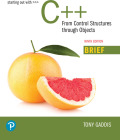
Concept explainers
Describe the difference between the if /else if statement and a series of if statements.
“if/else”if statement:
- “if/else” ifis a conditional statement that controls the condition branching.
- It executes the statements after evaluating the conditional expression.
- The “if” statement evaluates the test expression and when it is evaluated as true, the statement inside the body of “if” statement is executed.
- If the test expression is evaluated as false, it moves to the next if/else statement and the process continues till it reaches the finalif/else statement.
- If the test expression is evaluated as false, the statements in the “else” is executed.
Syntax:
//if conditional statement
if(condition)
{
Statement1
}
//if condition statement2
else if(condition)
{
Statement2
}
//else part
else
{
Statement3
}
Series of “if” statement:
A condition statement that controls the condition branching. The “if” statement evaluates the test expression and when it is evaluatedas true, the statement inside the body of “if” statement gets executed.
Syntax:
// if conditional statement1
if(condition)
{
Statement1
}
// if conditional statement2
if(condition)
{
Statement2
}
Explanation of Solution
Difference between if/else if statement and a series of if statement:
| if/else if statement | if statement |
| The condition gets tested until one conditional block is found to be true. | The conditions get validated for each of the condition cases given in a series. |
| The conditions are being evaluated to true to execute the statement. On evaluating true, the statement gets execute and exits the controls. | Each series of condition needs to be evaluated for the execution of series of statement present. The control gets validated for each condition and based the valuation of condition; the control exits the condition. |
Want to see more full solutions like this?
Chapter 4 Solutions
EBK STARTING OUT WITH C++
Additional Engineering Textbook Solutions
Vector Mechanics For Engineers
Modern Database Management
Starting Out with Java: From Control Structures through Data Structures (4th Edition) (What's New in Computer Science)
Computer Science: An Overview (13th Edition) (What's New in Computer Science)
Mechanics of Materials (10th Edition)
Introduction To Programming Using Visual Basic (11th Edition)
- Using R languagearrow_forward(Using R language)arrow_forwardAfter our initial deployment for our ML home based security system, the first steps we took to contribute further to the project, we conducted load testing, tested and optimize for low latency, and automated user onboarding. What should be next?arrow_forward
- Why investing in skills and technology is a critical factor in the financial management aspect of system projects.arrow_forwardwhy investing in skills and technology is a critical factor in the financial management aspect of systems projects.arrow_forwardWhy are requirements changing a significant source of risks in system projects?arrow_forward
 C++ for Engineers and ScientistsComputer ScienceISBN:9781133187844Author:Bronson, Gary J.Publisher:Course Technology Ptr
C++ for Engineers and ScientistsComputer ScienceISBN:9781133187844Author:Bronson, Gary J.Publisher:Course Technology Ptr EBK JAVA PROGRAMMINGComputer ScienceISBN:9781337671385Author:FARRELLPublisher:CENGAGE LEARNING - CONSIGNMENT
EBK JAVA PROGRAMMINGComputer ScienceISBN:9781337671385Author:FARRELLPublisher:CENGAGE LEARNING - CONSIGNMENT Programming with Microsoft Visual Basic 2017Computer ScienceISBN:9781337102124Author:Diane ZakPublisher:Cengage Learning
Programming with Microsoft Visual Basic 2017Computer ScienceISBN:9781337102124Author:Diane ZakPublisher:Cengage Learning C++ Programming: From Problem Analysis to Program...Computer ScienceISBN:9781337102087Author:D. S. MalikPublisher:Cengage LearningNp Ms Office 365/Excel 2016 I NtermedComputer ScienceISBN:9781337508841Author:CareyPublisher:Cengage
C++ Programming: From Problem Analysis to Program...Computer ScienceISBN:9781337102087Author:D. S. MalikPublisher:Cengage LearningNp Ms Office 365/Excel 2016 I NtermedComputer ScienceISBN:9781337508841Author:CareyPublisher:Cengage Microsoft Visual C#Computer ScienceISBN:9781337102100Author:Joyce, Farrell.Publisher:Cengage Learning,
Microsoft Visual C#Computer ScienceISBN:9781337102100Author:Joyce, Farrell.Publisher:Cengage Learning,





